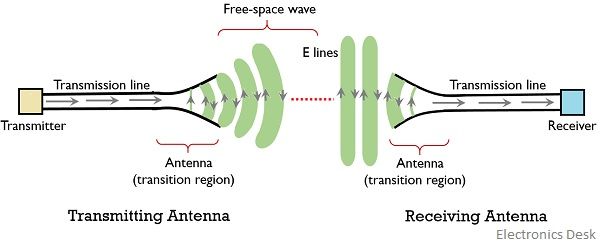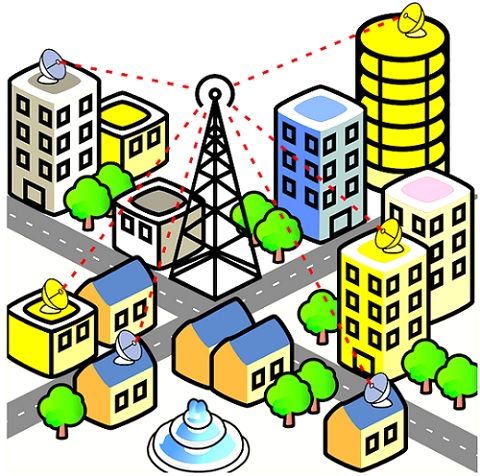Definition: Antennas are considered to be the fundamental part of a wireless communication system. An Antenna is a device that changes the RF signal into an equivalent electromagnetic wave. So that it can be transmitted into free space.
As we know that antennas are required at the time of both transmission and reception. Thus radio wave communication needs transmitting as well as receiving antennas.
Content: Antenna
Basic Concept
In a communication system, the transmitting antenna converts an electrical signal into radio waves and send it to the receiver and the receiving antenna receives the radio waves and generates an equivalent electrical signal.
This electrical signal is then provided to the transmission line. Thus we can say that it serves the role of a transitional element between free space and transmission line (guiding device).
In simple words, antennas are transducers that change RF electrical signal into an electromagnetic wave of similar frequency. The figure below illustrates the transmission and reception of radio waves in free space:

The electromagnetic wave emitted from antennas propagate in free space with speed of light (i.e., 3 * 108 m/s).
Need for Antenna
We have already discussed that antennas are considered to be the basic building block of a wireless communication system. As signal in free space propagates in the form of an electromagnetic wave then it requires some transmitting as well as receiving ends.

So, an antenna allows the propagation of electromagnetic waves from one end to another, in the form of EMW without the need for a wiring system. It acts as a transducer that converts RF signal into EM wave at the transmitter and EM wave back to an electrical signal at the receiver.
Antennas do so by producing electric and magnetic field from the applied signal and combinedly the two fields form an electromagnetic wave. As the two fields show perpendicularity with respect to each other. Thus
E.H = 0
In our day to day life, we regularly come across the use of wireless communication. As it includes signals arriving at the television for watching numerous programs to communicating with any person on a mobile network, everything is associated with wireless communication. Thus holds the need of antenna.
Functions of Antennas
1. Transducer: It acts as a transducer as it converts one form of energy into a different form.

As at the transmitting end, an electrical signal is transformed into a radio wave and receiving end changes radio waves back to electrical form.
2. Impedance matching device: It performs the task of impedance matching device as the antennas at the two ends are perfectly matched. This is done to ensure that the transmitted signal can be completely received without much reflections.
This simply shows that the maximal amount of transmitted power is transferred at the load.
3. Radiator and Sensor: The transmitting and receiving antennas act as radiators and sensors of electromagnetic waves respectively.
The transmitting antenna radiates the electromagnetic wave in free space while the receiving antenna senses the presence of an electromagnetic wave in the space and collects it.
4. Coupler: Another important feature possessed by the antennas is coupling. It acts as a coupler between the device that generates the RF signal and free space or free space and transmission lines.
Mechanism of Radiation in Antenna
An antenna is generally considered as a combination of various short conductors. A transmitting antenna when excited with RF electrical signal, then the charges present in the conductor start balanced motion.
This causes oscillations to build up inside antenna. These frequent changes in the charges lead to the generation of the electric and magnetic fields.
More simply, we can understand this as a general nature of moving charges.
When an electric current is provided to the conductor then the charges present in the conductors undergo back and forth movement. This leads to the generation of the electric and magnetic field that resultantly produces electromagnetic radiation in the form of radio waves.
And in this way, the disturbances from the antenna is spread into free space.
This electromagnetic radiation propagates with the speed of light and is received by the antenna present at the receiving end.
Now when the EM wave reaches the receiving antenna, then it sets up motion in the charges present in the conductor. Thus the moving charges generate current inside the conductor.
Hence the RF signal originally provided to the transmitting antenna is achieved by the receiving antenna and further given to the guided media.
Parameters of Antenna
The characteristics are as follows:
- Radiation Pattern: Radiating an equal amount of energy in all the direction is almost impossible for any practical antenna. As the energy radiated from an antenna specifically radiates maximal in one direction and minimum in rest other directions.
So, it is measured in terms of field strength. The field strength specifies the achieved radiation at a particular point at a certain distance from the antenna.
Thus it can be determined by the ratio of voltages between the two points on electric lines of force and the distance of separation between these two points. Thus its unit is volt per meter.
The radiation pattern shows significant importance as it helps in determining the radiated energy in space.
- Radiation Intensity: Unlike radiation pattern, radiation intensity does not show dependency with distance between sending and receiving antenna.
Radiation intensity is given as the power per unit solid angle. Thus its unit is watts/ steradian and is written as W/ sr.
- Directivity: Antennas are said to be isotropic in nature if they hold the tendency to radiate the energy Omni directionally i.e., equally in all the directions. But practically isotropic antennas do not hold existence.
If theoretically an isotropic antenna is considered, then the energy radiated by it must spread equally in various directions.
Thus the average power will be given as:

The directive gain of the antenna is defined in terms of the ratio of power density to the power radiated by the antenna on an average.
- Input Impedance: Impedance matching is one of the most important characteristics of the antenna.
As in order to ensure the maximal transfer of power from the antenna to the transmission line, the input of the antenna must be perfectly matched with the input of the guided media.
- Radiation Efficiency and power gain: As antennas are composed of conductors that possess finite conductivity. Thus certain losses are associated with it that are generally termed as ohmic losses.
So, the efficiency is defined as the ratio of power radiated by the antenna to the actually applied input power to the antenna.

On considering the losses associated with the antenna-
The overall input power will be the sum of radiated power and power loss.
Thus the efficiency will be given as:

Hence the power gain is given as the power radiated by the antenna in a specific direction to the originally applied input power to the antenna.
- Bandwidth: Bandwidth specifies the frequency range up to which the characteristics of the antenna do not show variation from a certain specified value.
- Effective length: The effective length of the antenna is specified as the length of imaginary linear antennas that have a uniform distribution of current with similar far-field in π/2 plane.
- Effective Aperture: It is also known as an effective area and it forms a relationship with receiving antenna. As the effective aperture is defined as the ability to gather electromagnetic energy from space.
Applications
As antennas are the base of wireless communication thus have numerous day to day applications. These are used in radio and television signal transmission along with GPS and navigation system. Antennas are used in satellite communication, remote sensing, and biomedical applications as well.